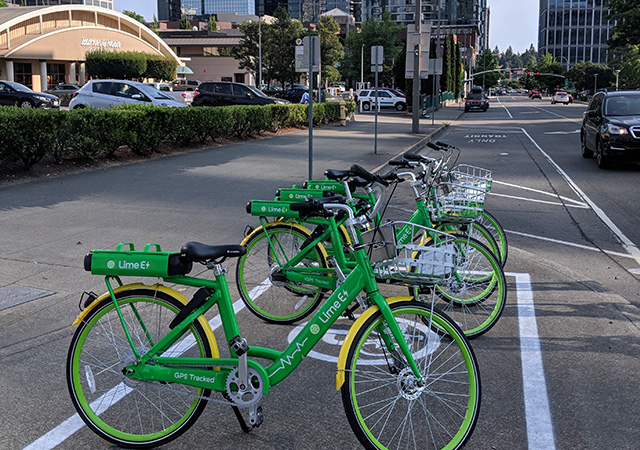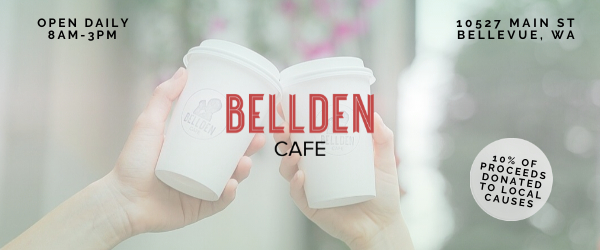
According to multiple sources, Lime recently announced that they will not be renewing their bike share program with the city of Bellevue. The one-year pilot program provided 400 e-bikes throughout the city, mainly in downtown Bellevue.
Lime’s permit was extended through fall 2019 while the evaluation of the pilot was completed. Over 9,000 people used the bike share program since it had launched the year prior. The city of Bellevue wanted community feedback and suggested improvements for the Bellevue bike share experience.
The transportation company announced that they will be focusing most of their market on scooters. There is a possibility that the city and Lime could partner in the future with other modes of transportation.
According to The Seattle Times, the transportation department plans to revise its permit conditions if any bike-share operator shows interest in the future. The goal for 2020 remains consistent with making bikes available and keeping public spaces accessible and hardly impacted.
Bike lanes were incorporated into the lanes running along 108th Avenue Northeast between Main Street and Northeast 12th Street in downtown Bellevue in July 2018. The project cost $365, 933 and was funded by The Neighborhood Safety, Connectivity and Congestion Levy.
In August of 2018, the bike share pilot program with Lime began in Bellevue. The bikes were electric-assisted and went as fast as 15 miles per hour. The pilot was intended to provide people who work, live and visit Bellevue with more choices of how to get around the city.
Lime currently has a bike share program in Seattle.













Good!
Not good!
Woot-woot! This bike craze makes no sense on any level; fiscal, environmental, social, etc.. It kills people, drives up costs, and results in more co2.
No surprise…not a sustainable business model without hefty taxpayer-funded subsidies by “woke”, virtue-signalling politicians. Now, can we get our traffic lanes back?
LimeBike failed for a variety of reasons. In spite of the City of Bellevue giving bike rental businesses unique, preferential treatment by allowing them to operate through a Right Of Way Use Permit (rather than as a Permitted Use, a requirement for virtually every other business in Bellevue), the enterprise still did not meet either Bellevue’s reasonable Permitting Conditions or the financial goals of LimeBike.
As cluttered as the City’s sidewalks and adjacent public properties were when LimeBike was operating, it could have been much worse. Market support for was so low LImeBike failed to place the minimum number of bikes available for rent that were required as part of their permit. Interestingly, the big concern when the City’s Transportation Commission was setting the performance standards for bicycle rental businesses (aka “bike share”) was that too many bikes would be placed around town. Not having enough customers to support even the minimum requirement clearly demonstrates there’s little demand for rental bikes. Furthermore, the vehicles themselves turned out to be lemons. Reports are the bikes required much more maintenance than anticipated. In addition, picking them up and transporting them to more appropriate locations proved costly and less than environmentally sound. That’s not all, LimeBikes customers routinely broke both City and State law by not wearing helmets. This dangerous, illegal behavior also ran directly counter to Bellevue’s Vision Zero goals.
There’s more to this story, too. The City implemented LimeBike’s bicycle rental program at the same time it opened the so-called “pilot” program for enhanced bike lanes on 108th Avenue N.E. This was clearly an attempt to inflate the bike ridership numbers on this bike route. LimeBike did do this, for the several weeks in the summer that ridership was measured. As a matter of fact, LimeBike contributed all the net new ridership on the bike lane. A whopping 25 trips a day. On a road that carries 11,400 motorized vehicles a day. A road that is designated Bellevue’s Transit Priority Corridor. In other words, taking away road capacity, increasing buffers between motorized vehicles and bikes, and severely limiting curb access along 108th Avenue N.E. for the enhanced bike lane failed to “induce” demand for the bike lane. Now that LimeBike has withdrawn from Bellevue, it’s probable there will only be the same paltry number of bikes using it as before the capacity reducing changes were installed along 108th Avenue N.E. in Downtown Bellevue. Hopefully, Bellevue will be more prudent when considering whether or not scooters should be allowed to operate on public right of ways, given the unexpectedly abysmal failure of the City’s LimeBike experiment.
Noooooo! I was away to Europe for 2 month. Come back last week and was wondering were are all Lime bikes gone. I was using them all the time. ?
Interesting idea but came with a poorly implemented structure. How Lime expects cities to accept random bicycles distributed across neighborhoods to be an acceptable solution makes little sense. Early usage data from City of Bellevue didn’t appear to match visual evidence, but it was clear from the start that opponents were not drivers, but residents.